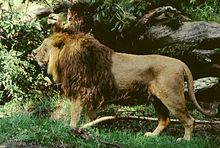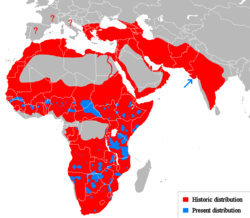Asiatic lion
| Asiatic lion | ||||||||||||
|---|---|---|---|---|---|---|---|---|---|---|---|---|

Asiatic lion |
||||||||||||
| Systematics | ||||||||||||
|
||||||||||||
| Scientific name | ||||||||||||
| Panthera leo persica | ||||||||||||
| ( Meyer , 1826) |
The Asiatic lion ( Panthera leo persica ), also known as the Persian lion or Indian lion , is a subspecies of the lion . The original distribution area reached as far as south-east Europe and the Middle and Near East . Today it only occurs in the wild in the Indian state of Gujarat in the Gir National Park on the Kathiawar peninsula .
Evolution and characteristics

According to molecular biological studies, the subspecies split off from the African lion 50,000 to 100,000 years ago.
The Asiatic lion looks quite similar to the African lion, but is generally a bit smaller. The males reach a weight of 160 to a maximum of 190 kilograms, the females between 110 and 120 kilograms. The shoulder height is approx. 110 cm. The Asiatic lion reaches a maximum body length of 290 cm. The largest measured body length of a male Asiatic lion was 292 cm, from the tip of the nose to the tip of the tail.
The coat is short and beige to sandy in color. He has a shorter mane and the elbow hair is significantly longer than that of the African relative. One of the most important morphological characteristics of the Asiatic lion is the formation of a longitudinal skin fold in the middle of the abdomen, which is not found in either male or female African lions , especially in adulthood. Another characteristic is the male's smaller, less developed and less voluptuous mane, which does not completely cover the ears. However, there are also almost maneless males in Africa. The African and Asiatic lions also differ genetically and slightly osteologically from one another. Half of the lions in the Gir National Park have double foramina infraorbitalia (nerve outlet openings under the eye) in the skull structure .
Way of life
Like the African lion, the Asiatic lion lives in packs. However, the pack size is on average smaller than the African representative. Female lions in Gir National Park live in groups of two to six individuals and young animals.
habitat
The habitat of the Asiatic lion encompassed both deciduous forests and drier areas such as savannas with a proportion of thorn forests.
nutrition
The hunt is up to the females. The males of the pack only take part in the hunt in exceptional cases. Lions usually hunt in the dark or in the cool morning hours. The prey animals of the Asiatic lion include axis deer , Indian gazelles , Nilgau antelopes , sambar deer , four-horned antelopes and wild boars . Lions also eat carrion.
Reproduction and development
Reproduction is not tied to the seasons and takes place all year round, but observations have shown an increase in the number of births in the late winter and early summer months.
After a gestation period of around 110 days, the lioness gives birth to two to four helpless cubs in a protected environment. The young lions are weaned at the age of six months and then stay with their mother for about two years. This development roughly corresponds to that of other big cats or the development of African lions. The boy mortality is 33%: 3 out of 9 young animals die in a total of four litters of a lioness.
In the Asiatic lion, the females reach sexual maturity at around four years of age, one year earlier than the males. The reproductive period ends at 15 years on average for both sexes.
The life expectancy of the Asiatic Lion is 17 to 18 years old in females than in males, who reach 15 to 16 years of age.
Persistence and protection
The Asiatic lion was heavily hunted and almost extinct. In 1913 there were only 20 individuals left. The nawab of Junagadh , who once hunted the animals himself, finally placed the Asiatic lions that remained in the Gir forest under protection. To protect the lions, the Indian government banned lion hunting in 1955. As a further measure, the Gir National Park , which covers 1153.42 km², was created in 1965 , in which the population was able to grow again. Ten years later, the reserve was enlarged and a core area of 258.71 km² was created.
The low population of the Asiatic lion at the beginning of the century led to a loss of genetic diversity ( bottleneck effect), which in turn resulted in inbreeding. Furthermore, the animals were endangered by diseases due to the decimated numbers.
With an estimated number of 250 to 300 specimens, the continued existence of the subspecies is not certain, but stable. The Asian lion is therefore in the Red List of the IUCN ( International Union for Conservation of Nature and Natural Resources "critically endangered") and ( critically endangered performed). The number of reproductive animals is estimated at around 175.
A cross with African lions ( Panthera leo leo ) is possible, but would not serve to preserve the pure-bred subspecies and is also problematic.
In the meantime there are efforts to settle the Asiatic lion in another Indian reserve, the Kuno game reserve , in order to establish a second wild population.
Zoo population

The lions, which until 1987 in zoological gardens outside India under the name P. l. persica were not purebred Asiatic lions. Genetic studies have shown that they differed greatly from the Indian lions of the Gir National Park (see blue arrow on the above map of the original distribution) and that they were partly due to African lions. This finding is also underlined by the lack of certain characteristics. As a rule, the males of these lions do not have a belly fold, a feature that occurs in almost all Asiatic lions. In the Asiatic lion, the mane is not particularly well developed and is almost always poorly developed, especially in the area of the ears. In contrast, the African lion's mane is more variable and often covers the ears almost entirely. At that time only the lions in the Indian Sakkarbaug zoo in Junagadh could be considered as pure Asiatic lions . These go directly back to wild catches from the Gir National Park. For this reason, two purebred breeding pairs from Junagadh were brought to London Zoo in 1990 and a new European Conservation Breeding Program (EEP) was set up with them. The Asiatic lions that are shown in European zoos today go back to lions of proven Indian origin and can therefore be described as purebred Asiatic lions.
mythology

The lion slayer motif has become the royal emblem of the medieval Chandella and Hoysala dynasties.
literature
- Kristin Nowell, Peter Jackson: Status Survey and Conservation Action Plan. Wild cats. IUCN - The World Conservation Union, 1996, ISBN 2-8317-0045-0 , pp. 118-122. (PDF download; 23.4 MB)
- David Macdonald: The Great Encyclopedia of Mammals. Könemann, Königswinter 2004, ISBN 3-8331-1006-6 .
- Ronald M. Nowak: Walker's Mammals of the World. Johns Hopkins University Press, Baltimore 1999, ISBN 0-8018-5789-9 .
- John Seidensticker , Susan Lumpkin: Big Cats. Jahr-Verlag, Hamburg, ISBN 0-86438-233-2 , pp. 92-93.
Web links
Individual evidence
- ↑ Asiatic lion at vox.de
- ^ Kristin Nowell, Peter Jackson: Status Survey and Conservation Action Plan. Wild cats. P. 37.
- ↑ John Seidensticker, Susan Lumpkin: Big Cats. P. 92.
- ↑ Grit Hoffmann: Olfactory components of the social behavior of Indian lions (Panthera leo persica). Diploma thesis University of Potsdam, Diplomica Verlag, Hamburg, 2008, ISBN 978-3-8366-2012-3 .
- ↑ John Seidensticker, Susan Lumpkin: Big Cats. P. 92.
- ^ Kristin Nowell, Peter Jackson: Status Survey and Conservation Action Plan. Wild cats. P. 37.
- ^ Kristin Nowell, Peter Jackson: Status Survey and Conservation Action Plan. Wild cats. P. 37.
- ↑ Frankfurt Zoo: Asiatic Lion ( Memento of the original from November 20, 2014 in the Internet Archive ) Info: The archive link was inserted automatically and has not yet been checked. Please check the original and archive link according to the instructions and then remove this notice.
- ↑ John Seidensticker, Susan Lumpkin: Big Cats. P. 92.
- ↑ IUCN: Panthera leo ssp. persica , accessed June 23, 2013.
- ↑ Frankfurt Zoo: Asiatic Lion ( Memento of the original from May 23, 2014 in the Internet Archive ) Info: The archive link was automatically inserted and not yet checked. Please check the original and archive link according to the instructions and then remove this notice.
- ↑ AJT John Singh, SP Goyal, Qamar Qureshi: Preparations for the reintroduction of Asiatic lion Panthera leo persica into Kuno Wildlife Sanctuary, Madhya Pradesh, India. In: Oryx. 41, No. 1, 2007, pp. 93-96 ( doi : 10.1017 / S0030605307001512 ).
- ^ SJ O'Brien et al: Evidence for African origins of founders of the asiatic lion species survival plan. In: Zoo Biology. Volume 6, Issue 2, 1987, pp. 99-116.
- ↑ Asian Lion Project ( page no longer available , search in web archives ) Info: The link was automatically marked as defective. Please check the link according to the instructions and then remove this notice. , ZSL London Zoo

